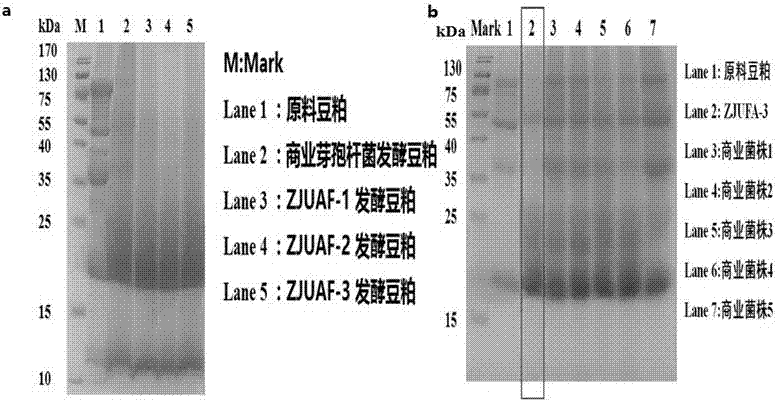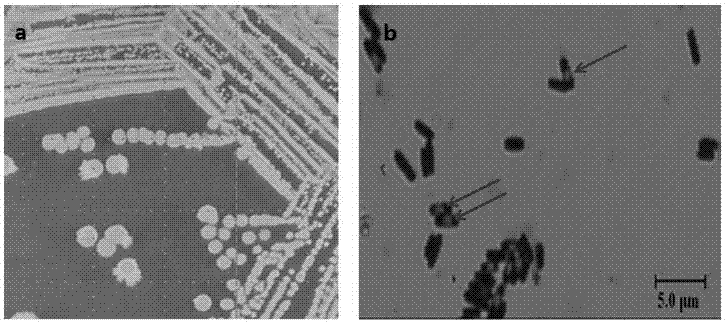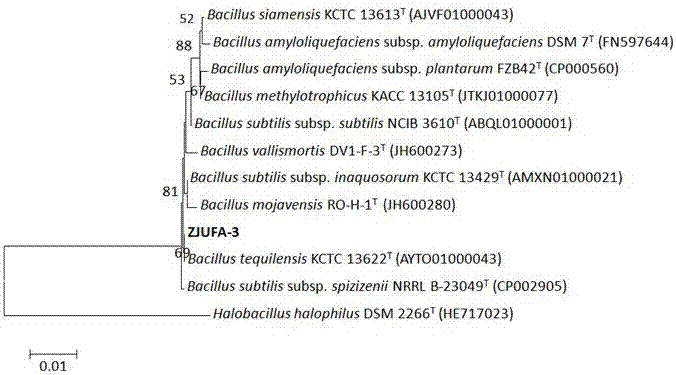Bacillus for efficiently degrading soybean meal antigenic protein and method for fermenting soybean meal
A technology of antigenic protein and bacillus, which is applied in the direction of microorganism-based methods, biochemical equipment and methods, bacteria, etc., can solve the problems of insignificant degradation of soybean meal antigenic protein and low nutrient loss, so as to facilitate animal absorption and utilization, and acid-soluble The effect of increasing the protein content and increasing the content of acid-soluble protein
- Summary
- Abstract
- Description
- Claims
- Application Information
AI Technical Summary
Problems solved by technology
Method used
Image
Examples
Embodiment 1
[0041] Embodiment 1: bacterial strain screening
[0042] 1. Separation 1g of traditional pickled vegetables in Jiangsu and Zhejiang regions, dissolved in 10ml sterile water, bathed in 75℃ water for 15min, then diluted with sterile water 10 times, and took 4 dilution gradients (10 -3 、10 -4 、10 -5 、10 -6 ) bacteria suspension on LB plates, at least 3 plates for each dilution, cultured at 37°C for about 24 hours to obtain a single colony.
[0043] 2. Preliminary screening Pick a single bacterial colony on the soybean meal antigen protein plate, incubate at 37°C for 24 hours, select the strain with a large hydrolysis zone, examine it under a microscope, and purify it by streaking to obtain the primary screening strain.
[0044] 3. Re-screening The strains were re-screened based on the degradation rate of soybean globinin and β-conglycinin based on the indicators. The specific process is as follows: put the strains obtained from the primary screening into LB liquid medium, unde...
Embodiment 2
[0047] Example 2: Characteristics of bacterial strains
[0048] 1. Morphological characteristics:
[0049] The strain ZJUFA-3 was streak cultured on LB medium at 37°C for 24 hours, and the growth morphology of the strain was observed. The results were as follows: figure 2 shown.
[0050] according to figure 2 As a result, the colony is milky yellow, nearly round, with a moist surface and translucent.
[0051] Pick a single colony therein and carry out Gram staining. After staining, it is purple, Gram-positive bacteria, oval, short rod-shaped, and spore-forming.
[0052] 2. Physiological and biochemical characteristics:
[0053] Pick a single colony among them, refer to the "Common Bacteria Identification Manual", and conduct physiological and biochemical characteristics detection. The detection items and results are shown in Table 2.
[0054]
[0055] 3. Genotype identification
[0056] The 16SrDNA sequence of ZJUFA-3 and the conserved gene gryB sequence were comp...
Embodiment 3
[0059] Embodiment 3: Fermentation effect comparison of several pretreatment processes of soybean meal
[0060] 3.1 Soybean Meal Pretreatment
[0061] Method 1. Add water and mix soybean meal (moisture content 11.13%), adjust the water content to 50%, do not sterilize, and obtain pretreated soybean meal 1;
[0062] Method 2. Add water and mix soybean meal (moisture content 11.13%), adjust the water content to 50%, and sterilize at 105°C for 15 minutes to obtain pretreated soybean meal 2;
[0063] Method 3. Soybean meal (moisture content 11.13%) was sterilized at 115°C for 15 minutes, then the water content was adjusted to 50wt%, and stirred evenly to obtain pretreated soybean meal 3.
[0064] 3.2 Fermentation of pretreated soybean meal
[0065] Take Bacillus subtilis ZJUFA-3, inoculate it in LB liquid medium, cultivate it at 37°C and 200 rpm for 12 hours, and obtain Bacillus subtilis ZJUFA-3 seed solution;
[0066] Add Bacillus subtilis ZJUFA-3 seed solution to the pretreate...
PUM
 Login to View More
Login to View More Abstract
Description
Claims
Application Information
 Login to View More
Login to View More - R&D
- Intellectual Property
- Life Sciences
- Materials
- Tech Scout
- Unparalleled Data Quality
- Higher Quality Content
- 60% Fewer Hallucinations
Browse by: Latest US Patents, China's latest patents, Technical Efficacy Thesaurus, Application Domain, Technology Topic, Popular Technical Reports.
© 2025 PatSnap. All rights reserved.Legal|Privacy policy|Modern Slavery Act Transparency Statement|Sitemap|About US| Contact US: help@patsnap.com



